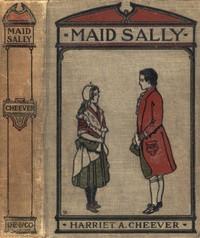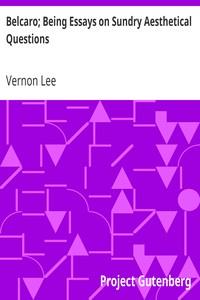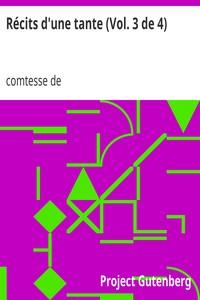Read this ebook for free! No credit card needed, absolutely nothing to pay.
Words: 81052 in 7 pages
This is an ebook sharing website. You can read the uploaded ebooks for free here. No credit cards needed, nothing to pay. If you want to own a digital copy of the ebook, or want to read offline with your favorite ebook-reader, then you can choose to buy and download the ebook.
Hence it is that the child, who will one day become ourselves, rarely cares to return to these sculpture galleries; or, if it care to return to any, it is to mixed galleries like those of Florence, where, instead of the statues, it looks at the pictures. And out of pictures, out of the coarse blurs of colour in picture-books, out of the black, huddled, infinitively suggestive engravings in bible and book of travel; out of fine glossy modern pictures which represent a definite place, or tell a definite story; out of all this, confused with haunting impressions, of things seen or heard of , do we get our original, never really alterable ideas and feelings about art; for much as we may clip, trim, and bedizen our minds with borrowed things, we can never change, never even recast its solid material: a compact, and seemingly homogeneous soul mass, made up of tightly-pressed, crushed odds and ends of impression; broken, confused, pounded bits of the sights and sounds and emotions of our childhood. To the statues we return only quite late, when this long-formed, long-moulded soul of ours has been well steeped in every sort of eclectic and artificial culture; has been saturated with modern art and modern criticism, with mysticism and realism and sentiment and cynicism, with Dante and Zola, and Mozart and Wagner and Offenbach, saturated, with every kind of critically distilled aesthetic essence, till there is not a flavour and not a scent, good or bad, sweet or foul, which may not be perceived in this strange soul of ours. Then we return to the statues; and, having imbibed a certain amount of Hellenic, Pagan, antique feeling, we try also to assimilate the spirit of the statues of Phidias or Praxiteles; we expound the civilisation, the mode of thought; we trace the differences of school, we approve and condemn, we speak marvellously well, with subtlety or passion; we imagine all manner of occult, ineffable virtues and vices in this antique art, we dabble deliciously in alternate purity and impurity , as we even occasionally, for a few moments, feel actual, simple, unreasoning, wholesome pleasure in the sight of the old broken marbles. All this we do, and most often are therewith satisfied. Yet if, weighing our artistic likings and dislikings, comparing together our feelings towards so many and so various manifestations, trying to determine what is fresh and wholesome food to our depraved aesthetic palate, and what is mere highly flavoured, spicy or nauseous drug-stuff, if, in such a moment of doubt, we ask ourselves, overheard by no one, whether in reality this antique art is, in the life of our feelings, at all important, comforting, influential? we shall, for the most part, whisper back to ourselves that it is not so in the very least. But could it ever have been? Could this, or any art have been for us more than merely one of a hundred feebly enjoyed, more or less exotic mental luxuries; than an historic fossil, by study of which, as with the bone of a pterodactyl or an ichthyosaurus, we can amuse ourselves reconstructing the appearance and habits of a long dead, once living civilisation? Or might these statues have been much more to us? Might they, perhaps, have shaped and trained our souls with their unspoken lessons?
Well, once upon a time , a child was brought to the Vatican: just such an one, only perhaps a trifle more wayward, than those we met this morning, demurely led about, or scampering through the galleries: its name signifies nothing, suffice it that it was a child. Now, it so happened, that upon that day the statues are merely stone imprisoned demons, dethroned gods of antiquity, were bent upon getting some small amount of amusement in their dreary lives: all the more dreary since the great joyful hope of restoration in the hearts of men which they had conceived when Winckelmann and Goethe came to them and adored, had been slowly disappointed by seeing that what men cared for was not them, but merely their own impertinent theories and grandiloquent speeches. The Statue-demons were sick of the bitter amusement of watching the follies of their pretended or deluded worshippers. So they sorely wanted excitement, diversion of some sort; and in their idleness, they capriciously determined to amuse themselves, no longer with grown men, but with children. So, as a toy for the moment, they singled out this particular child we are speaking of, who was wandering wearily through the gallery, overpowered like its companions by the sense of negativeness, of greyness, of silence, of want of character and movement and story, and as it passed them, the statue-demons looked at each other with their pupilless eyes, as much as to say: "This is the one we shall take," and determined to cast a spell upon it which would make it theirs. How they did is more than any of us can tell: there was a little gurgling fountain in the garden outside, where a broken-snouted dragon spirted a trickle of water through the maiden-hair choking up the basin, and of this water the child did drink a little in the palm of its hand, the rest running up its sleeve; there was also an old noseless Vertumnus in a corner, on whose pedestal a great tuft of wild grass had shot up, and round whose arms and neck an ivy plant had cast its green trailing leaves; and one of these bitter glossy leaves that child did certainly munch; but whether the charm was in the water or the leaf, or in neither, and only a mysterious spell, a sort of invisible winged seed of passion which they cast direct into that little soul, no one may ever decide. Be it as it may, the child remained for a while conscious of nothing at all, never dreaming that it had in any way come in contact with that demon world imprisoned in the stone. It lived its child life of romping and day dreams and lessons and punishments, and, with its companions, fretted to get away from this dreary, horrible Rome of the popes: this warm, wet place with its sordid houses, its ruins embedded in filth and nettles; its tawdry, stuffy churches, filled with snuffling of monks and jig-quavering of strange, cracked, sickening-sweet voices; its whole atmosphere of decay and sloth, as of a great marsh-pond, sprinkled with bright green weed and starred with flaunting nauseous yellow lilies. The child wondered at all these things: dug bits of porphyry and serpentine out of gutters, collected pieces of potshard from the Palatine; read and re-read the stories of shipwrecks and red Indians and volcanoes: played in dressing-gowns and shawls, at processions of cardinals and prelates, and, with yelling companions in pinafores and napkins, at church music, with tremendous time-beating with rolls of paper; laughed and pouted and quarrelled as children do; quite unconscious of being the chosen one, the changeling, the victim of the statues. But little by little, into its everyday life, stole strange symptoms; sometimes there would come like a sudden stop, as of a boat caught in the rushes, a consciousness of immobility in the midst of swirling, flowing movement, a giddy brain-swimming feeling; and then things went on again just as before. But the symptoms returned, and others with them. What was the matter? A vagueness, a want; a seeking, a clinging, but seeking for, clinging to the unknown. In the evenings of early spring, when the children had returned from their scrambling walks, and were waiting for supper, chattering, looking at books, or strumming tunes; this child would watch the bank of melting colours, crimson, and smoke-purple and gold, left by the sun behind the black dome of St. Peter's; and as the white vapours rose from the town below and gathered on the roofs like a veil, it would feel a vague, acheless pain within it; and at any stray, trifling word or bar of dance music, its eyes and its whole little soul would fill with a mist of tears. The spell cast by the statues was not idle, the mysterious philter which they had poured into it was working throughout that childish soul: the child was in love; in love with what it had hated; in love intensely, passionately, with Rome. And as a part of Rome it loved, blindly, for no other reason, that desolate Vatican; to the statues it returned, and in a way, grew up in their presence. And one day the child looked at itself, and perceived that it was a child no longer; knew all of a sudden, that in those drowsy years of childish passion and day dreams, it had been learning something which others did not know. For it heard one day a few pages of a symphony of Mozart's; the first it had ever heard save much more modern music; and those bars of symphony were intelligible words, conveyed to the child a secret. And the secret was: "we are the brethren, the sounding ones of the statues: and all we who are brethren, whether in stone, or sound, or colour, or written word, shall to thee speak in such a way that thou recognise us, and distinguish us from others; and thou shalt love and believe only in us and those of our kin." Then the child went forth from the Vatican, and went in among the pictures, and among the poems and the music, and did indeed find that all those who were of the same kin as the statues spoke to it intelligible words, and returned its love by making it happy. This came of the statues having had the whim of giving to that child the love potion which had made it love Rome.
All this is a fairy tale, a very meagre one indeed, quite inferior to any told us by nurse or peasant woman; but a fairy tale nevertheless; for, of course, we all know that statues cannot give love philters, nor children fall in love with towns, nor symphonies talk about having brothers in marble or colour. All this is rubbish of the same sort as the dancing water, the singing apple, the dragon Fafner's blood which made Sigurd understand the language of the birds, the enchanted lake into which Charlemagne sat gazing out his life, because of the ring cast into it; mere rubbish, and, consequently, not to be examined into or reasoned about. But as the wise men of to-day tell us that in all our nursery tales there is a hidden, sensible meaning; perhaps, also, there may be one in this absurd little story of the child in the Vatican, and that we may see. And so, now, we must be serious and examine methodically into the matter.
Come and stand at a little distance from the table on which the wooden gable and statues are set. So, now we can get an idea of the general effect of the group. It seems so simple, but it is not: it is in sculpture something like what a fugue is in music: it is a homogeneous form due to the extremely skilful co-ordination of various forms; it is a harmonious whole, because the parts are combined just at the point where their diversities coalesce. For, as the various voices of the fugue, some subtly insinuating themselves half whispered, while the others are thundering their loudest or already dying away into silence, meet and weave together various fragments of the same melody, so also do the figures of the group, some standing, some reclining, some kneeling, some rising, some draped, some nude, meet our sight in various ways so as to constitute in their variety, one great pattern; balance each other on opposite sides of the gable, slope and taper down towards the extremities, grow and rise higher towards the middle where the vertex of the triangular temple front, the triumphant centre of the rhythm and harmony of lines, is formed by the majestic, magnificent mother between her two eldest, most beautiful daughters. And now, think no more of this terra-cotta than, having learned the shape of a hymn by Bach or a psalm by Marcello on the piano, you would think of the poor miserable piano-notes which you hear with your ears, instead of the mass of voices which you hear with your fancy. Think of this Niobe group, twice humansized, standing on the weather-mellowed, delicately painted marble temple front; the amber-tinted figures against the dark hollow formed by the projecting roof; the sunshine drawing on the black back-ground, as with a luminous pencil, the great solemn masses of light and shadow, the powerfully rhythmed attitudes, the beautiful combinations of lines and light and shade produced by the gesture, which now raises, now drops the drapery, opposing to the large folds, heavy and severe, the minute, most supple, and most subtle plaits; and to the strong broken shadows of the drapery, the shining smoothness of the nude. Think of that, and remember then the single figures in their best examples, the mother and eldest daughter of Florence, the headless younger daughter of the Vatican, the exquisite dying boy of Munich; and think, by recollecting these dispersed noblest copies, what must the lost original have been. And thus, looking at the little rough terra-cotta model, and magnifying it in fancy into the great superb group such as it must have stood on the temple, there comes home to us, filling, expanding our mind, an almost ineffable sense of perfection of line and curve, and light and shade, perfection as of the sweeping wave of some great mountain, distant and deep blue against the pale sky; perfection as of the pearled edge of the tiny pink cyclamen petal; as of the single small voice, swelling and diminishing in crisp exquisiteness every little turn and shake, and again as of the many chords of multitudinous voices rolling out in great joyous sound billows; perfection of whole in harmony and graduation of perfect parts: perfection of visible form.
But by the side of this overwhelming positive sense of beauty there creeps into our consciousness an irritating little sense of negation. For the more intense becomes our perception of the form, the vaguer becomes our recollection of the subject; the strong imaginative realization of the story of Niobe, conjured up by the mere mention of her name, dwindles to nothing in the presence of the group representing the chief incident of history; the skrieks and desperate scuffling of feet, which we had heard in our fancy, gradually die into silence; our senses cease to shrink with horror, our sympathies cease to vibrate with pity, as we look upon this visible embodiment of the terrible tragedy. We are no longer feeling emotion; we are merely perceiving beauty. How has this come to pass? Shall we look into ourselves and analyze in the darkness of our consciousness? Nay, rather first look for an explanation in the materially visible, the clear, easily examined work of art. Come and look at the group once more: this time not to understand its beauty, but to understand why there is in it nothing beyond this beauty.
Certainly, the group answers very well to the general idea of the massacre of the Niobides: the figures have the attitudes of men and women overtaken by a sudden danger against which they seek, but vainly, to shield themselves: the mother clasps the cowering, clinging, youngest girl, and tries to cover her with her mantle, her arms, her whole body, to let the child melt into herself and be lost; the youngest son sinks, panting and helpless, on to one knee; the eldest daughter bends forward to throw her veil over a dead brother; the younger daughter mechanically raises her draped arm to ward off the shafts from her face; another son hastens away, looking bewildered around him, trying to see from which side come the arrows, which come from all sides. All this is perfectly correct in expression; we are bound to admit that these are the probable movements and gestures of people situated like Niobe and her children. We cannot find fault with anything, yet we feel a vague sense of unreality. Unreality to ourselves? Nay, rather, unreality to the artist: we perceive, little by little, that everyone of these evident indications of a catastrophe is connected with a grand gesture, a noble fold, a harmonious combination of masses: the mother raising the arm covered with her cloak and clasping the child with the other, produces thereby a magnificent contrast between the round, bunched fold of the mantle, and the straight, narrow folds of her skirt, nay, between the simple and ample drapery covering her own bosom, and the minute clinging crinkles on the back of the little one; the wounded youth sinks down in such a way as to display the grand muscles of his throat and shoulders; the girl covering her naked dead brother, forms with him, a powerfully-balanced mass of brightly-lit nude and broken, shadow-furrowed drapery; and all the remaining children stoop and cower and stretch forth their arms in such a way as to produce the inclination of the two sides of the triangle crowning the temple. Moreover, the pathetic, upward movement of the mother's head, by slightly drawing down the jaw, and in upturning the eyes, contracting the brows into a triangular furrow, accentuates the grandeur of the grand features, and prevents the light from above falling upon a mere flat expanse of cheek and forehead; the eldest daughter stooping tenderly over the dead boy produces, in so doing, an incomparable curve of neck and shoulders; and thus, with all the other figures, the gesture is invariably productive of a definite beauty of form. And, on the other hand, there is not present a single one of the gestures or attitudes which would certainly produce definite ugliness of form, and would yet be as appropriate and inevitable to the situation as these. There is not, in this group, any movement, any effect, of which we could decidedly say that it would not arise in a scene like this; but, in a scene like this, there would certainly be a great many movements and effects which cannot be found in the group. Hence, the dramatic expression of the work is essentially negative: in the mind of the artist the realisation of the scene, the bringing home of the story, has been a purely secondary thing, and therefore the realisation of the scene, the bringing home of the story, is secondary also to us, the spectators. The impression produced in us is exactly corresponding to the interest dominant in the artist: he has cared for the subject only inasmuch as it afforded suggestions for beautiful forms; and we therefore have perceived the beautiful forms, and forgotten the subject. The object of the artist has been, whether or not he formulated it clearly to himself, not to bring home the situation to the fancy; not to awaken an emotion; but to present to the eye and the mind a mere beautiful form. And that such has been his object, is the first and main lesson which we have learned from the Niobe group, as it was the first and main lesson learned by the child of our fairy tale from the innumerable statues which, during those long years in the Vatican, were its silent teachers.
Can the Niobe teach us more? Has your Vatican child learned any more from the statues? you ask, contemptuous at this definition, narrow, as must be all definitions of duty. Perhaps the Niobe may teach us next how this highest artistic quality of beauty, this sole aim of the artist, is to be attained? Be not so contemptuous. The Niobe can teach us something about the mode of attaining to this end; it cannot, indeed, teach us what to do, for the knowledge of that, the knowledge of how to combine lines and curves and lights and shades, is the secret belonging to the artist, to be taught and learned only by himself; but it can teach us what not to do, teach us the conditions without which those combinations of lines and curves and lights and shades, cannot be created. Let us return to the Niobe once more: let us see the group clearly in its general composition, and then, with the group before us, let us ask ourselves what plastic form is conceived in our imagination when there comes home to it the mere abstract idea of the sudden massacre of the Niobides, by Apollo and Artemis. Nothing, perhaps, very clear at first, but clearer if we try to draw what we see or to describe it in words. In the first place, we see, more or less vaguely, according to our imaginative endowment, a scene of very great confusion and horror: figures wildly shuffling to and fro, clutching at each other, writhing, grimacing with convulsed agony, shrieking, yelling, howling; we see horrible wounds, rent, raw flesh, arrows sticking in torn muscles, dragging forth hideous entrails, spirting and gushing and trickling of blood; we see the mother, agonised into almost beast-like rage and terror, the fourteen boys and girls, the god and the goddess adjusting their shafts and drawing their bows; we see all, murderous divinities, writhing victims, impotent, anguished mother. If we see it, how much more fully and more clearly, in every detail, is it not seen in the mind of the sculptor, of the man whose special gift is the conception of visible appearances? Oh, yes, he sees it: here the mother, here the elder daughters, there the other children, further off, Apollo and Artemis, sees how each stands, moves, looks, sees the convulsed features, the rumpled garments, the fear, the pain, the anger, the hopelessness, the pitilessness. He takes three planks, nails together their extremities: this is the gable of the temple, the triangular cavity or box into which he must fit his group; then, with thumb and fingers, roughly moulds a certain number of clay puppets, places them in the triangular box, removes them, alters them, replaces them, takes them out once more, throws some away, elaborates others; works for hours, days, weeks, till we return to his workshop, and find a number of models, tiny moulded dolls in the plank triangle; large statuettes, half-finished, roughly-worked heads--drawings, perhaps, of parts of the group. And we examine it all. It is the rudiment of the Niobe group. But see: of all those things which we saw in our fancy, which the artist, being an artist, must have seen with infinitely more completeness and clearness, only a portion has here been reproduced. Of all the movements and gestures there remain but a very few: the convulsions, the writhings, and grimacings are gone; there is no trampling, no clutching, no howling, no grimacing, there are no quivering limbs, or disembowelled bodies. Why so? Ask the artist. Because, he will answer, all those movements and gestures were radically ugly; because all that howling and grimacing in agony entirely ruined the beauty of the features; because the situation could not be adequately represented, except to the utter detriment of the form. Hence, of all the movements and gestures which had presented themselves to his inner vision, at the first mention of the story of Niobe, the artist has rejected those which were at all detrimental to the beauty of the form, and accepted those others which were conducive thereto. He has cast aside a whole portion of the real appearance of the event, because it interfered with his, perhaps unspoken and unformulated, but instinctively imperious artistic aim: to create beautiful form.
But this is not all. He has left out something else which was a most essential, nay, an all important part of his first mental vision of the scene. He has actually left out--guess what--some son or daughter of Niobe?--has run counter to the tradition of the seven girls and seven boys?--oh, in comparison, that would be nothing. He has actually and absolutely left out the god and goddess--left out the murderers from the representation of the murder. Why in the world has he done this? Granting that he need not transfer to his group all the terrible details he has seen in his mind, why should he leave out Apollo and Artemis? They need not be convulsed, or writhing, or grimacing; on the contrary, they ought to be quite calm and passionless in their cruel beauty. There is nothing unbeautiful in Apollo and Artemis surely. No: not in Apollo and Artemis, taken in themselves; but in Apollo and Artemis considered as part of this group. Listen: we will explain. Since Apollo and Artemis are, between them, slaughtering all the Niobides, closing them in with their arrows, it is obvious that Apollo and Artemis must be placed in such a manner as to command the whole family of Niobides; there must be no Niobides behind them, for that would mean that there are Niobides who are out of danger and can escape. So the god and goddess must be placed in one of three ways: either back to back in the very centre of the group, each shooting down one half of the family; or else entirely separated, each at one extremity of the group, so as to face each other and enclose all the Niobides between them; or else above the Niobides, floating in mid air and raining down arrows like hail. Now, which of these three arrangements shall the sculptor select? He rejects at once the plan of placing the god and goddess back to back in the centre of the group, and we agree with him; for the two figures, thus applied to each other, each more or less in profile, would form the most ludicrous double-headed Janus. Place, then, Apollo at one end and Artemis at the other. There is nothing ugly in that, is there? There would not be were the sculptor modelling the oblong bas-relief of a sarcophagus; but there would be something very ugly now that, as it happens, he is modelling a group for the triangular gable of a temple. For, as the sides of the triangle slope sharply down, the figures beneath them necessarily become smaller and less erect in proportion to their distance from the vertex; so the god and goddess, if placed at the extremity of the group, must be flattened down in the acute angles of the base, must crouch and squat with their bows barely on a level with the knees of their victims. So this arrangement will not do; there remains the third plan of placing Apollo and Artemis above the Niobides. This is an admirable idea: the vertex of the triangle is filled by the floating figures of the gods, who appear calm, beautiful, mysterious, showering down death from inaccessible heaven. Will this do? Alas, much less than either of the others. The arrangement would be beautiful if the triangle of the gable, instead of being filled with a group of statues, were walled up, plastered, and could be painted on in fresco. The colour, light and shade, and perspective of painting, by creating a seeming depth of back-ground, by hiding one figure partially behind another, so as to make them appear not in actual contact, by piling up aetherial clouds or waving light draperies, would permit the artist to show the Niobides on solid ground below, and the gods in the air, high, distant above. But the sculptor, without any such means, could only suspend Apollo and Artemis in such a way that they should seem to be standing on the shoulders of the Niobides; or interpose between them a thick bolster of marble clouds, a massive flutter of streaming marble draperies. Now do you think that the marble clouds and the marble fluttering drapery would be conducive to the beauty of the group, to the perfection of visible forms? Certainly not. And, therefore, Apollo and Artemis, gods though they are and chief actors in the story, have simply been left out in this its artistic representation.
For beauty of form has a double origin: it is not only an intellectual conception, but also a physical embodiment; and the intellectual conception is altered by the nature of the material in which it is embodied. The abstract form which will be infinitely delicate and life-like in the brown clay, which receives every minute dimple and crease from the finger of the artist, which presents a soft, uniform tint to the spectator; this same abstract form will be coarse and lifeless in the purple speckled porphyry, against whose hard grain the chisel is blunted, and the mottled colour and salt-like sparkle of which hide from the eye the real relations of line and curve, of concave and projection. The Mercury who, in the green bronze, floats upwards like a bubble, would jump like a clodhopper in the dingy white plaster. And these, remark, are differences only in one category of material and handling; change the sort of material and manner of handling and the differences become still greater. Statues, whether in clay, bronze, porphyry, or plaster, are always similar in the fact of being wholly free--round as Vasari calls them--of being interfered with by no complications of shadows like the figures of a high, middle or bas-relief; hence, as soon as the figures cease to be round, as soon as they are attached to a back-ground, the whole composition is altered by the consideration how the different degrees of projection, and the consequent play of light and shadow, will affect the apparent shape of the figures. And yet we are still within the domain of sculpture. How great a difference of form will not result when, instead of the tintless, tangible projections of stone, we get to the mere semblance of infinite depth and distance cunningly obtained by light and shade, colour and perspective, on a flat surface; where the light, instead of existing variable and confusing outside the work, is within that very work, inside the picture, combining, graduating every detail, making form melt gently into form, or stand out in triumphant relief? Thus the things which can be done in bronze must not be attempted in porphyry, the group of statues must be conceived differently from the bas-relief; the picture is different from the statue; for the beauty of form depends not only on the conception but upon the embodiment: if the material is violent, the conception is warped; and the same beauty can be obtained in all the arts only by remembering that those arts are different that, with the material and modes of handling, must change the conception.
Thus we have seen that the sculptor of the Niobe deliberately refused to embody his complete mental vision of the scene of massacre; that he selected among the attitudes and gestures and expressions suggested to him by this scene, rejected those which were inherently ugly, and accepted those which were intrinsically beautiful; and that he left out of his representation of the incidents its principal actors, because he could not have introduced them without either violating the nature of the whole composition to which he was bound, or violating the nature of the material in which he was working, and by so doing sacrificing the perfection of visible form which, being the only intrinsic quality to which his art could independently attain, was the one object of his desires and efforts. Such is the logical conclusion which we have consciously and perhaps wearisomely obtained from our analysis of the mode of conception and treatment of the Niobe group; and such the lesson which, unconsciously, vaguely, the child of our fairy tale must have learned from its marble teachers in the Vatican: That the only intrinsic perfection of art is the perfection of form, and that such perfection is obtainable only by boldly altering, or even casting aside, the subject with which this form is only imaginatively, most often arbitrarily, connected; and by humbly considering and obeying the inherent necessities of the material in which this form is made visible or audible. That by such artistic laws they themselves had come into existence, and that all other things which had come into existence by the same laws, were their brethren, was the secret which those statue-demons imparted to that child; the secret which enabled it to understand those symphony notes of Mozart's, when they said: "we also, the sounding ones, are the brethren of the statues; and all we who are brethren, whether in stone, or sound or colour, shall to thee speak in such a way that thou recognize us, and distinguish us from all others; and thou shalt love and believe only in us and those of our kin; in return we will give thee happiness." And this, as we have told you, came to pass solely because the statues took the whim of bewitching that child into falling in love with Rome.
ORPHEUS AND EURYDICE.
THE LESSON OF A BAS-RELIEF.
Free books android app tbrJar TBR JAR Read Free books online gutenberg
More posts by @FreeBooks

: Maid Sally by Cheever Harriet A Harriet Anna Davidson Bertha G Illustrator - Girls Juvenile fiction; United States History Revolution 1775-1783 Juvenile fiction; Virginia History Colonial period ca. 1600-1775 Juvenile fiction


: The Old Soldier's Story: Poems and Prose Sketches by Riley James Whitcomb - American wit and humor; American poetry








